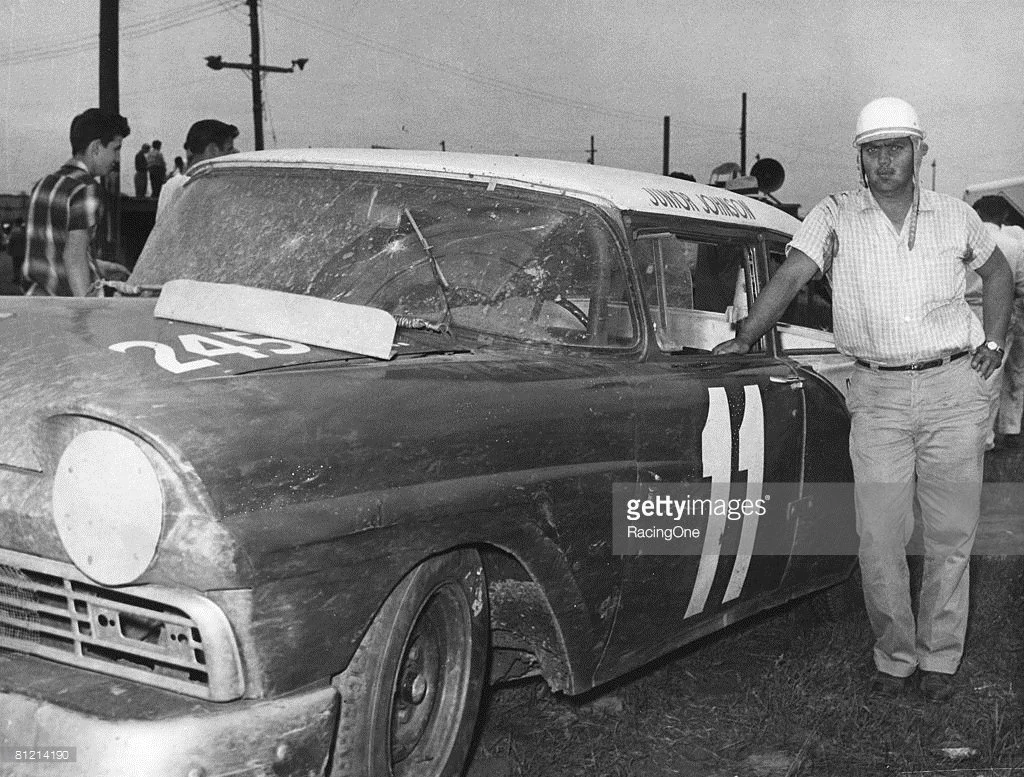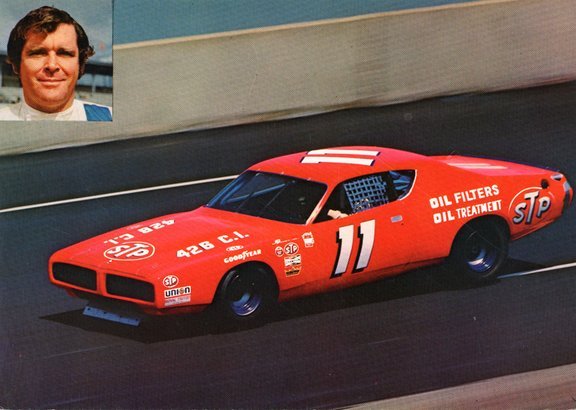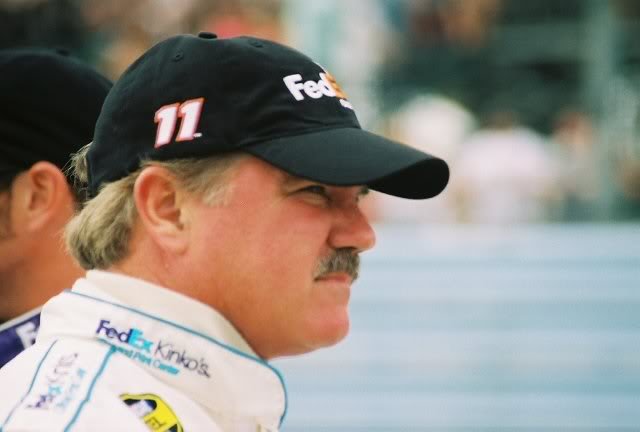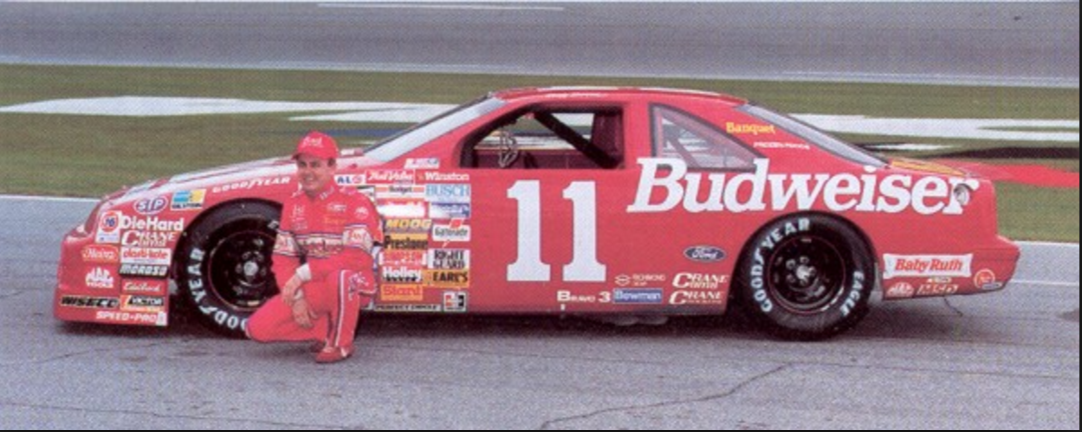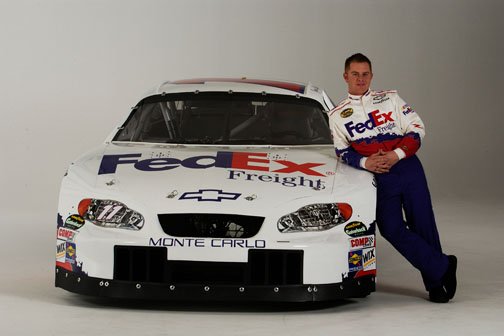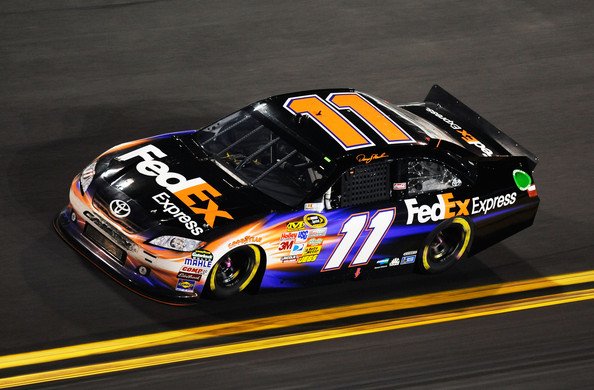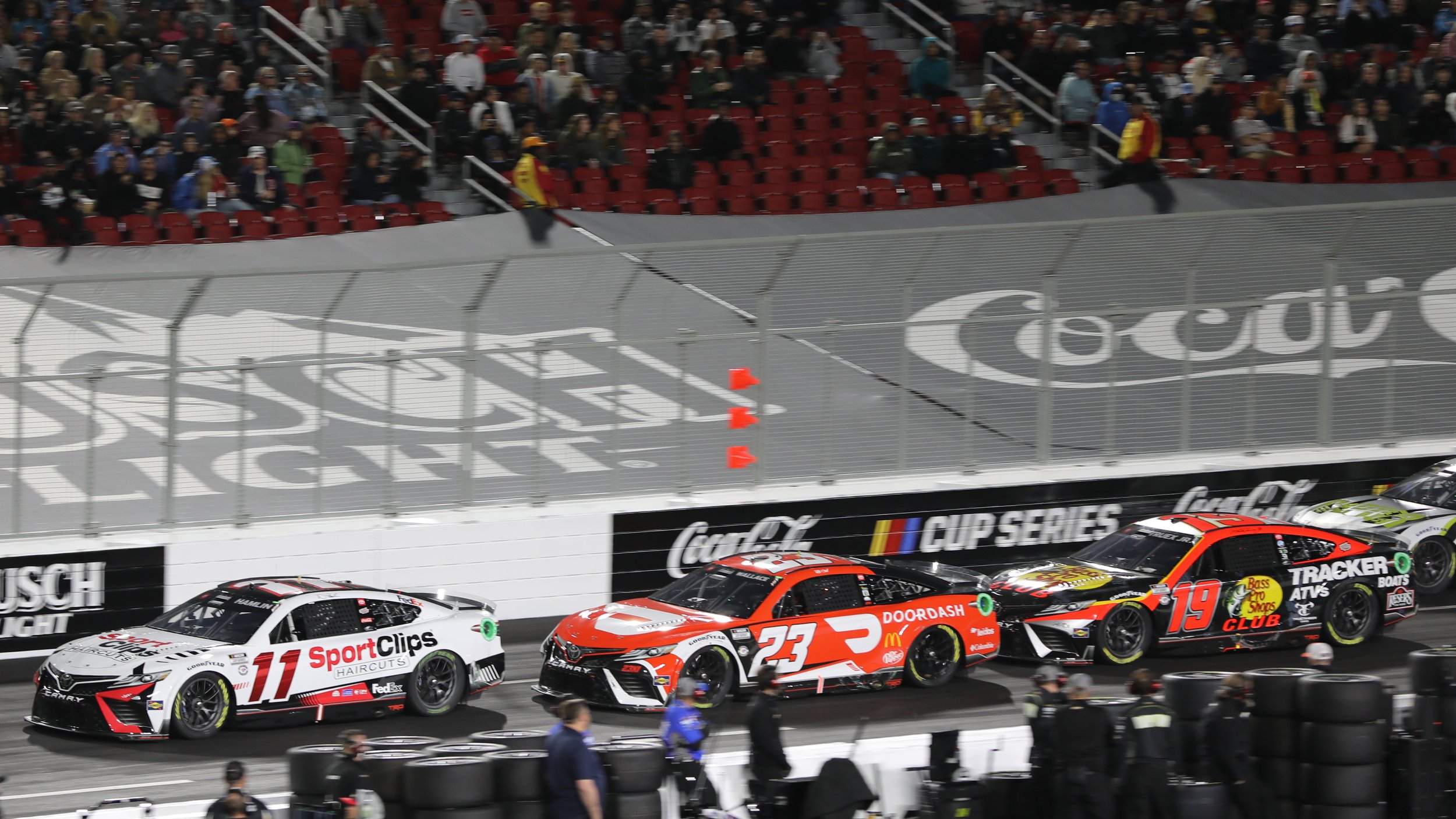
In NASCAR Cup Series competition the #11 car has started 2,164 races with 87 drivers and has 231 wins, 169 poles, 815 top 5s, and 1,106 top 10s.
Mostly Famous for driving #22, Fireball Roberts made 22 starts in #11 from 1950-1957.
Junior Johnson started #11 54 times from 1958-1960 with 11 wins. In 1955, Johnson began his career as a NASCAR driver. In his first full season, he won five races and finished sixth in the 1955 NASCAR Grand National points standings.
In 1958 he won six races. In 1959, he won five more NASCAR Grand National races; by this time he was regarded as one of the best short-track racers in the sport.
His first win at a superspeedway came at the Daytona 500 in 1960. Johnson and his crew chief Ray Fox were practicing for the race, trying to figure out how to increase their speed, which was 22 miles per hour slower than the top cars in the race. During a test run a faster car passed Johnson. He noticed that when he moved behind the faster car his own speed increased due to the faster car’s slipstream. Johnson was then able to stay close behind the faster car until the final lap of the test run, when he used the “slipstream” effect to slingshot past the other car. By using this technique Johnson went on to win the 1960 Daytona 500, despite the fact that his car was slower than others in the field. Johnson’s technique was quickly adopted by other drivers, and his practice of “drafting” has become a common tactic in NASCAR races.
In 1963 he had a two-lap lead in the World 600 at Charlotte before a spectator threw a bottle onto the track and caused Junior to crash; he suffered only minor injuries. He retired in 1966. In his career, he claimed 50 victories as a driver, and 11 of these wins were at major speedway races. He retired as the winningest driver never to have a championship.
Ned Jarrett drove the #11 car 323 times from 1959-1966. His 50 career victories are tied for 10th all-time with Junior Johnson, 49 of which came in #11. He also won a total of 28 races during the 1964 and ’65 seasons. In 1959 he purchased a Junior Johnson Ford for $2,000. He did not have enough money to cover the check, so he waited until the bank closed to write the check, entered two races, and won them both to cover the cost of his car.
In 1960, he won five races and took the championship over Rex White in 1961. He was among the top five drivers in 22 races and missed being among the top ten drivers only 12 times out of 46 races, with one win. One indicator of the personal character of “Gentleman Ned” Jarrett is demonstrated by the decision to sell his 1961 (raced as #11) Chevrolet to Wendell Scott who travelled from his Virginia home to Ned’s shop on West “A” Street in Newton, NC to take delivery of the ’61 Chevy Bel Air (raced the previous season) when Ned changed to Fords in 1962. Wendell hauled the old blue 1961 Chevrolet Bel Air coupe away on the back of an open trailer.
Jarrett was once overheard talking with Bud Alman and John Ervin about the need to “run all the races” to win the championship. Races in those days sometimes included more than one race per week. Among the unique tracks of the early era was Bowman Gray Stadium in Winston-Salem, North Carolina which was actually the area around the football field inside the Bowman Gray Stadium. The race schedule was difficult. The race teams were smaller, often having only one or two paid members.
In 1965, Jarrett became a super star when he won 13 races and another Grand National championship. He placed among the top five in 42 of the 54 races that he ran. In 1966, Jarrett was in the run for another championship when Ford announced that they were withdrawing from NASCAR. With that, Jarrett decided that it was time to retire at the young age of 34. Jarrett is the only driver to retire as the NASCAR champion.
Between 1967-1968 Mario Andretti made 8 of his 14 career Cup series starts in #11 including his only career win- the 1967 Daytona 500.
Buddy Baker started the #11 Petty Enterprises Dodge 28 times from 1971-1972 with 2 wins- the Spring race at Darlington and the World 600 (Coca Cola 600) at Charlotte. Baker is one of nine drivers to have won a Career Grand Slam, by winning the sport’s four majors – the Daytona 500, Talladega 500, Coca-Cola 600, and the Southern 500.; Richard Petty, David Pearson, Bobby Allison, Darrell Waltrip, Dale Earnhardt, Jeff Gordon, Jimmie Johnson, and Denny Hamlin are the other eight to have accomplished the feat. Baker and Hamlin are the only ones of the nine to not win a championship.
Cale Yarborough won his three consecutive championships (1976-78) driving #11. After 2 years in USAC, In 1973, Yarborough returned to NASCAR and ran every in a season for the first time in his career, driving the #11 Kar-Kare Chevrolet for Richard Howard. He won four races, finishing second in points.
In 1974, Yarborough won a career-high ten races, but lost the championship by nearly 600 points. Midway through the season, Yarborough’s team was bought by Junior Johnson with Carling sponsorship. Yarborough swept both races at Riverside International Raceway, captured his fourth Atlanta 500, and his second consecutive Southern 500 and third overall. Despite his successful 1974 campaign, the team began 1975 without major sponsorship, and missed three races, before Holly Farms became the team’s primary sponsor. He won three races, including sweeping the events at Rockingham, but dropped to ninth in the final standings.
The following season, Yarborough won nine races, including four in a row late in the season along with the Firecracker 400, in winning his first career Winston Cup Championship. He repeated his nine-win performance in 1977, a season in which he finished every race and did not finish outside of the top-five during the last eleven races of the season, earning him his second championship. Another highlight of the season was his second Daytona 500 victory, earning him a cover appearance on Sports Illustrated, the 2nd NASCAR driver so honored. In 1978, his team switched to Oldsmobiles and received new sponsorship from 1st National City Travelers Checks. He matched his previous career high of 10 wins, and won his third consecutive championship.
Yarborough began the 1979 season with Busch Beer sponsorship and getting into a fight with Donnie and Bobby Allison after the Daytona 500 , when Donnie and Yarborough wrecked while racing for the lead on the final lap. This was the first NASCAR 500 mile race to be broadcast on live television in its entirety (through CBS Sports). The confrontation and the exciting race that led up to it are credited with starting the mass growth of NASCAR. Yarborough went on to finish fourth in the standings, winning four races, including the Coca-Cola 500 at Pocono Raceway and the National 500 at Charlotte Motor Speedway.
Yarborough won a career-high and modern-era record fourteen poles in 1980, captured six races including sweeping the events at Rockingham. Yarborough barely missed out on his fourth championship in five years, losing the championship to Dale Earnhardt by 19 points. At the end of the season, Yarborough announced he was leaving the Junior Johnson team and would run a part-time schedule for the rest of his career. He was replaced by Darrell Waltrip. Yarborough won 55 races while driving for Johnson from 1973–1980, compiling an amazing winning percentage of 26.57 percent.
Darrell Waltrip won his three titles (1981-82, 1985) while driving Johnson’s #11 in 178 starts for 43 wins from 1981-1986. In his first two years as driver for the Mountain Dew sponsored, Junior Johnson prepared Buick Regal, Waltrip won 12 races each year, 14 pole positions in each year, and his first two NASCAR Winston Cup Championships, in 1981 and 1982. Waltrip’s success and driving prowess helped to bring the Buick GNX into prominence, since he drove a Regal (whose platform spawned the GNX) during his years of sponsorship by Mountain Dew. The company later honored the Waltrip years with throwback paint schemes, once in 2006 and again in 2008.
It was during the early 1980s, with Junior Johnson, that Waltrip first worked with Jeff Hammond, a pit crewman for Johnson. Hammond was at first skeptical of Waltrip’s driving style since it differed so much from the former driver for whom he worked, Cale Yarborough. Yarborough made adjustments to his driving based on the handling of the car in a particular race whereas Waltrip wanted the car adjusted around his driving style. Hammond eventually came to appreciate Waltrip’s “finesse”, and smooth driving style which proved highly successful. Waltrip and Hammond would benefit from each other’s knowledge and abilities and would work together for most of their careers in the sport. Waltrip and Hammond work together, even today, as broadcaster and analyst at Fox Sports, and Speed TV.
Waltrip’s first season with Junior Johnson was a huge success. He won 12 races including big races such as the Southern 500, the Food City 500, and the Riverside 400 event. He almost set a win record at Talladega for his 1981 season (winning the big races) by nearly winning the Talladega 500. On the final lap rookie Ron Bouchard dove under Waltrip and Terry Labonte to take the lead. Bouchard beat Waltrip by a foot in a 3-wide drag race in what has been called the biggest upset in NASCAR history. Waltrip reportedly said “Where the hell did he come from?” in an interview. He ended 1981 with 11 poles, 12 wins, 21 top fives, and 25 top tens. Four of his 12 wins were consecutive. Not only did Waltrip win 12 races, he also won the Winston Cup championship against nemesis Bobby Allison by over 72 points.
In 1982, Waltrip won 12 races and basically repeated his 1981 season. He won the Winston Cup championship again against Bobby Allison.
During the 1983 Daytona 500, on February 20, 1983, Waltrip, a pre-race favorite to win the race, driving the Junior Johnson prepared 1983 Chevrolet Monte Carlo SS Pepsi Challenger, spun on lap 64, at exit of turn 4, at nearly 200 mph, as he was making an evasive maneuver to avoid rear-ending a much slower car ahead of him. Waltrip locked his brakes but the car slid for several hundred feet, then slammed hard into an earthen embankment near the entrance to pit road. The force of the impact was so violent that the car was thrown back onto the track, in front of oncoming traffic. The car then made hard contact with the outside concrete retaining wall. The car bounced off the concrete retaining wall, again into oncoming traffic. Cale Yarborough, the eventual winner of the race, barely avoided hitting the demolished Pepsi Challenger. Waltrip suffered a concussion and was taken to nearby Halifax Medical Center for observation and medical treatment. The crash was a wake-up call and a life-changing event for Waltrip. The years following that crash would see a different Darrell Waltrip, one who worked hard to repair and rebuild his relationship with fans and fellow drivers. Years later, Waltrip would be voted “Most Popular Driver”, two years in a row, (1989, 1990).
Waltrip would continue his unprecedented success driving for Junior Johnson through the 1986 NASCAR Winston Cup season, winning his third NASCAR Winston Cup Championship, in 1985, winning the inaugural all-star race, The Winston, in 1985, and compiling 43 additional wins.
But Waltrip was quick to recognize the new and rapid expansion of the sport’s popularity, evolving and expanding interest in NASCAR, even among housewives, teens and young adults, and others never before considered NASCAR fans, all primarily due to increasing national network and cable subscription television which televised almost every NASCAR event live, and the growing interest of new family oriented sponsors never before associated with motorsports. NASCAR was becoming a multi-regional, multi-racial, and multi-national and multi-cultural sport enjoyed by men, women and children alike. In addition to the huge influx of money from new sponsors and television, the more astute NASCAR team owners immediately embraced new resources, such as computers, telemetry, research and development, multi-car teams for information sharing, wind-tunnel testing, and the procurement of aerodynamicist, computer modelers, and structural engineers. Waltrip, now one of two drivers for Johnson, was quick to envision the future of NASCAR and sought to take advantage of the coming changes, something his car owner, Junior Johnson, although a pioneer of the sport, was somewhat reluctant to embrace. Afterall, Johnson had enjoyed success for decades and won numerous races and championships spanning decades using his own formulas for success.
Waltrip, well aware of Junior Johnson’s long-standing, steadfast rule of never discussing an adjustment to a driver’s contractual salary, and never really comformfortable with the allocation of resources that Johnson’s two car team required, approached Johnson about an increase in his contract salary. Although the story, as told by Waltrip, is most likely fokelore, Waltrip drove his final race for Junior Johnson November 16, 1986, in a Chevrolet sponsored by Budweiser, finishing 4th, in the Winston Western 500, Riverside International Raceway in Riverside, California, completing one of the most successful owner/driver partnerships in all of motorsports history. Waltrip and Johnson remain close friends and have huge respect for each other as driver and owner and pioneers of the sport.
In 1987 Terry Labonte left Hagan’s team to drive the #11 Budweiser Chevrolet for Junior Johnson. In his first season with his new team, he earned four pole-position starts and won the Holly Farms 400, leaping up to third in the final standings. He followed that up with a fourth-place points finish in 1988, including a win in the All-Star Race. In 1989, the team switched to Ford Thunderbirds. Despite two wins during the season, he fell back to tenth in the championship. Labonte would breifly return to the #11 with Joe Gibbs in 2005 driving at Sonoma and briefly driving the car after Leffler was released, before Hamlin was signed. Texas Terry started 92 races in #11 with 4 wins.
Geoff Bodine started Junior’s Budweiser car 55 times in 1990 & 1991 including 4 of Geoff’s 18 career wins.
Bill Elliott drove Johnson’s #11 to five wins (including four in a row) and three poles, but much like his 1985 season he finished a disappointing second in the championship standings after squandering a large lead in the standings with a late season string of poor finishes. He did win the season finale at his home track in Atlanta, but lost the championship by 10 points to Alan Kulwicki, who finished in second place and had led the most laps by one over Elliott. Had Kulwicki not led the most laps, Elliott would have finished tied with him for the lead and would have been awarded the title on a tiebreaker due to him having more wins. He was the last driver to win in the #11 for Junior Johnson, in 1994. It would be the time the number appeared in Victory Lane until Denny Hamlin’s rookie win at Pocono. Elliott started the #11 car 90 times with 6 wins from 1992-1994.
In 1995 Brett Bodine signed with Junior Johnson piloting the Lowe’s Ford Thunderbird. He posted two top ten finishes and finished twentieth in points. After the season, Johnson sold the team to Bodine and his wife Diane. Bodine also bought former boss Kenny Bernstein’s old team and merged them together to form Brett Bodine Racing.
Bodine struggled to produce results as an owner driver and constantly battled with funding, though he did recieve support from Ralph’s and Hooters.
In 2003. Bodine attempted to run at Indy in a fan sponsored “Brick Car” where, for $500, fans would get their name on the car. The program was a success, but Bodine failed to qualify for the race by .001 seconds. Rumours of a sponsor for 2004 and beyond surfaced, but nothing panned out and the team was sold. After all the recent events and struggles, he decided to retire from driving. Brett started 256 races in #11 with no wins.
In 2005 Jason Leffler drove #11 in 19 starts. Leffler missed the Coca-Cola 600 at Charlotte, with FedEx Freight moving over to the 18 car that Bobby Labonte would drive to a second place finish. After 19 starts with a best finish of 12th and sitting 36th in points, Leffler was released from the ride. In November, it was announced that Denny Hamlin would drive the car for the remainder of the season, then run for Rookie of the Year in 2006.
Denny Hamlin has the most starts in #11 with 614 including 48 wins. In 2005 Hamlin ran seven races, finished in the top 10 three times, and earned a pole at Phoenix International Raceway. Hamlin was awarded the #11 FedEx Express full-time ride in 2006. Hamlin opened the season by winning the Budweiser Shootout non-points race, holding off Dale Earnhardt, Jr. on a green-white-checker restart. In June, Hamlin scored his first Cup Series victory at the difficult Pocono Raceway. Hamlin started on the pole, then battled back from a cut tire to take the victory. In his return to the track in July, Hamlin again won the pole, then proceeded to lead all 200 laps en route to a second victory, the first rookie to sweep both Pocono races. Hamlin’s strong performance earned the rookie a berth in the Chase for the NEXTEL Cup, where he would finish 3rd in points.
In 2007, Hamlin won the first of two races at New Hampshire International Speedway and finished 12th in points. In 2008, Hamlin won the Gatorade Duel and the first race at Martinsville Speedway. He ended the season with four victories after winning Martinsville and Homestead-Miami Speedway in the chase. 2010 was Hamlin and the 11 team’s breakout year. They won at Martinsville and Denny followed the win by having knee surgery. After the surgery, the team won 4 of the next 10 races at Texas, Darlington, Pocono, and Michigan. The team made the chase after another win at Richmond. The team won races during the chase at Martinsville and Texas and held the points lead going into the season finale. However, an early wreck would put them behind the competition. The team struggled throughout 2011, with multiple blown engines and a single win at Michigan to push the #11 into the Chase. Hamlin would finish 9th in the final standings.
Under Darian Grubb the team started 2012 off in the best way possible by winning the second race of the season at Phoenix. That win was followed with another victory at Kansas six weeks later. The 11 team once again proved dominant on the short tracks pulling off a convincing win in the Bristol Night Race in August. The week after Bristol, the No. 11 FedEx team brought home another victory at Atlanta Motor Speedway, making the No. 11 the car number with the most wins in NASCAR with 200 wins. Hamlin then won the Sylvania 300, giving Joe Gibbs Racing its 100th win.
Hamlin’s 2013 season began with an on-and-off track feud with former teammate Joey Logano. Initially started on Twitter, the on track incidents began at Bristol in March, where Hamlin spun Logano in turns 1 and 2, leading Logano to confront Hamlin after the race. The rivalry continued into the next race at Auto Club Speedway , where the two fought for the lead in the closing laps. In the final corner, the two collided, allowing JGR teammate Kyle Busch to win the race, and sending Hamlin’s 11 car into a non-SAFER barrier wall near pit road. He suffered a lower back fracture and was forced to sit out several races. Veteran Mark Martin replaced Hamlin at one of Denny’s better tracks, Martinsville Speedway, where he scored a top 10. Brian Vickers then drove the car for the next three races, scoring an 8th place finish at Texas. Though Hamlin returned to the car at Talladega Superspeedway, he never returned to form during the year, with only 8 top 10s on the year. He did score a win at the season finale at Homestead.
After Jason Leffler’s death in 2013, the 11 team paid tribute to their former driver by running a white FedEx scheme at Michigan similar to the one Leffler ran in 2005.
In the 2014 Auto Club 400, Sam Hornish, Jr. replaced Hamlin due to Hamlin having what was thought to be sinus infection, but later revealed to be a piece of metal in his eye that impaired his vision. Denny was medically cleared by NASCAR to still be eligible to compete in the Chase for the Sprint Cup. Hamlin made it to the final 4 in Homestead, but a 7th place finish would relegate him to 3rd place in the standings behind Kevin Harvick and Ryan Newman.
In 2015, Hamlin qualified for the Chase early with a win at Martinsville. Despite the hard racing, Hamlin commended Brad Keselowski for not wrecking him to win the race. At the spring Bristol race, Hamlin was replaced by Erik Jones after 22 laps due to suffering from neck spasms. Hamlin would also win the Sprint All Star Race and the first race of the Chase for the Sprint Cup at Chicagoland, but after being involved in “the Big One” at Talladega Hamlin would be eliminated in the second round, finishing 9th in points.
With new crew chief Mike Wheeler replacing Dave Rogers, Hamlin won the 2016 Sprint Unlimited. In the Daytona 500, Hamlin made a pass on Joe Gibbs Racing teammate Matt Kenseth for the lead on the final lap. Hamlin and Martin Truex Jr. were side-by-side for the win as they crossed the start-finish line, but Hamlin – who led a race-high 95 laps – prevailed by 0.011 seconds over Truex, making it the closest Daytona 500 in history. bringing Joe Gibbs Racing its first Daytona 500 victory since 1993.
After his huge Daytona 500 win he struggled a bit. In the next 10 weeks Hamlin managed only 3 top-10 finished. Hamlin would find success later in the season picking up wins at Watkins Glen and the Fall race at Richmond. Hamlin would make it to the Round of 8 in The Chase before being eliminated at Phoenix.
Hamlin had a slow start to the 2017 season, along with his Joe Gibbs Racing teammates. Hamlin had to wait until July to pick up his first win of the season at New Hampshire. Hamlin would visit victory lane again at Darlington, but this victory would later be declared “encumbered” after failing post race tech with trailing arm issues.
At the fall race at Martinsville Hamlin made contact with race leader Chase Elliott with 3 to go. Unhappy with Hamlin, Elliott drove him to the outside wall after the race on the cool-down lap. “My mom always said if you don’t have anything nice to say don’t say anything at all,” Elliott told NBCSN. “He’s not even worth my time. … We had a good opportunity. I can’t control his decisions and whatever the hell that was. On to Texas.” Elliott later got an apology from Hamlin after the race via twitter.
At Phoenix, Elliott was in a must-win situation to advance to Miami. Late in the race, while battling Hamlin for 3rd place, Elliott got his revenge for the Martinsville incident by nudging Hamlins car into the outside wall. The incident caused Hamlin to cut down a tire soon after. While Elliott would take the race lead shortly after the incident, he would ultimately lose the race to Matt Kenseth. Neither Elliott nor Hamlin would advance to the Championship 4 at Homestead.
Hamlin started the 2018 season with a third place finish at the 2018 Daytona 500. Despite being winless throughout the regular season, he made the playoffs by staying consistent with seven top-fives and 14 top-10s. Hamlin was eliminated in the Round of 16 after finishing out of the top-10 at Las Vegas, Richmond, and the Charlotte Roval. He wound up 11th in the final point standings, his first time outside the top ten since the year he missed 4 races due to injury (2013) and winless for the first time in his career, snapping a 12-season streak of winning at least one race dating back to his first full-time rookie year (2006).
Hamlin started the 2019 season by breaking a 47-race winless streak with his second Daytona 500 win, dedicating the victory to the late J. D. Gibbs. He scored his second win of the season at Texas. At the spring Dover race, Hamlin was rushed to the infield care center for carbon monoxide poisoning after an accident knocked out his car’s right rear crush panel and allowed fumes inside the cabin. Despite this setback, he stayed consistent throughout the season, scoring two more wins at Pocono and the Bristol Night Race.
Despite a 19th-place finish at the Charlotte Roval, Hamlin collected enough points to advance to the Round of 12. At Martinsville, Hamlin collided with Logano on turn four, squeezing Logano into the outside wall and causing him to lose a tire and spin out two laps later. Hamlin finished fourth while Logano salvaged an eighth-place finish. After the race, Hamlin and Logano had a discussion on the incident before Logano slapped Hamlin’s right shoulder, sparking a fight between the two. NASCAR suspended Dave Nichols Jr., the No. 22 team’s tire technician, for one race for pulling Hamlin down to the ground during the altercation.
Hamlin went on a tear during the Playoffs, scoring his fifth victory of the season at Kansas only two weeks prior and ultimately advancing to the Championship 4 for the first time since 2014 with his sixth victory of the year at Phoenix. At Homestead however, Hamlin was a non-factor for the victory and Championship despite starting from the pole as he led only 2 laps, made an unscheduled pit stop to fix overheating issues after gambling with extra nose tape, and only recovered from a lap down to finish the race in 10th-place. He finished the season fourth in points in his first season with Gabehart as crew chief, a 7-spot improvement over the previous season along with six victories after being winless the year prior.
Hamlin won his third Daytona 500 in 2020 when he beat Ryan Blaney to the finish in overtime by 0.014 seconds, the second-closest finish in the race’s history behind Hamlin’s 2016 win. The victory was overshadowed by Ryan Newman’s wreck coming to the finish that resulted in hospitalization, sparking controversy over Hamlin’s post-race burnouts while Newman’s health was unknown; Hamlin and Joe Gibbs apologized for the celebrations, the former explaining he had not learned of Newman’s status until he was in Victory Lane.
In the regular season, he scored dominant wins Darlington, Homestead, Pocono, Kansas and Dover. With his win at Pocono, Hamlin passed Mark Martin for second most-wins by any driver that has never won a championship, behind Junior Johnson’s 50 wins. After Kevin Harvick’s unexpected elimination from the playoffs, Hamlin entered the Championship race at Phoenix as the driver to beat. He would ultimately finish 4th behind the new champion- Chase Elliott.
2021 saw Hamlin enter a new role as a co-owner of the #23 car and 23XI racing, along with former NBA star Michael Jordan. Denny would face a winless drought for the first half of the season, but he finally found victory lane in the late summer at the Southern 500. He would win again 3 weeks later at Las Vegas. Though he was part of the Championship 4, he would ultimately finish 3rd in the season standings.
In 2022, Denny would notch 2 wins at Richmond and Charlotte’s Coca-Cola 600. Hamlin was strong in the playoffs, and seemed like a contender for the title. He narrowly missed out on makings it to the Championship 4, as Ross Chastain’s last-lap “hail melon” at Martinsville would knock Denny out of the final round.
2023 began with Denny launching a new podcast: Actions Detrimental. After only 4 races, Hamlins podcast caused controversy after he admitted during an episode that he intentionally wrecked Ross Chastain in the closing laps of the race at Phoenix, costing Denny a $50, 000 fine and 25 points. Denny would qualify for the Playoffs with 2 wins in the regular season at Kansas and Pocono. His victory at Pocono was officially the 50th of his career. He would score another win during the playoffs at Bristol. With his win at Bristol, Hamlin surpassed Junior Johnson for most wins by a driver without a championship. In the round of 8, while running in the top-5 at Homestead, Hamlin experienced a steering failure and finished 30th. He would miss the Championship 4, despite a strong 3rd place run at Martinsville. Hamlin would finish 5th in the season standings.
Denny is already off to a strong start in 2024, winning the Clash at the LA Coliseum. To date he has 650 starts in #11 with 51 wins.
Other notable names in #11
Parnelli Jones, 13 starts, 1win
AJ Foyt, 6 starts
JJ Yeley, 6 starts
Bobby Allison, 4 starts, 3 wins
Rex White, 2 starts
Dave Marcis, 1 start
Ricky Craven, 1 start

